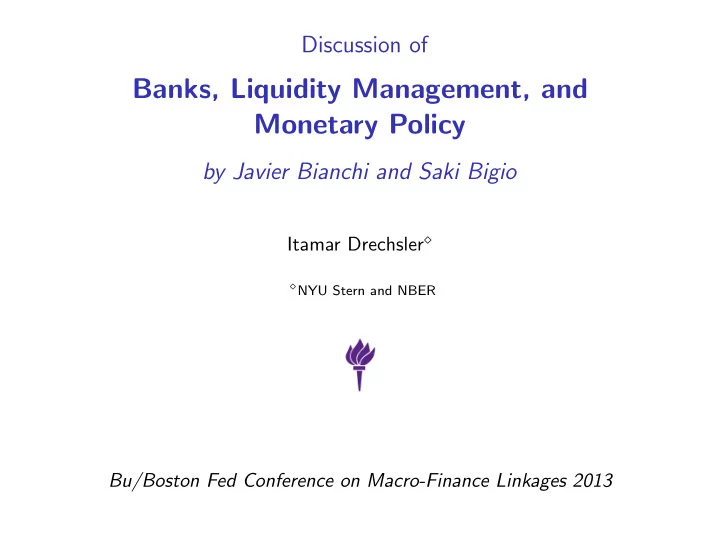

Discussion of Banks, Liquidity Management, and Monetary Policy by Javier Bianchi and Saki Bigio Itamar Drechsler ⋄ ⋄ NYU Stern and NBER Bu/Boston Fed Conference on Macro-Finance Linkages 2013
Objectives 1. To develop a model of how monetary policy works through and interacts with the banking system. • have an explicit role for the financial system/banks 2. Use the model to interpret stylized facts about the financial crisis and the policies undertaken by central banks • why banks have had large increases in reserves holdings without a correspondingly large increase in lending Discussion of Bianchi and Bigio (2013) 2 / 12
Model Agents: • Banks: have wealth (bank equity), derive power utility from dividend payouts • Depositors : lend to banks via demand deposits • no other role in the model • Central bank Time: each day has two periods • beginning of the day: a “lending stage” • end of the day: a “balancing stage” Discussion of Bianchi and Bigio (2013) 3 / 12
Model At the beginning of the day banks decide how much to: • borrow from depositors • invest in loans: high return • invest in “reserves”: low return • to satisfy a reserves requirement equal: a fraction ρ of deposits • reserves requirement is imposed at the end of the day At the end of the day: • Banks are hit by exogenous deposit withdrawal shocks • reserves depleted to redeem deposits • if reserves requirement is violated → must borrow shortfall from central bank • there is no interbank market for borrowing reserves • central bank levies a high penalty rate for borrowing reserves shortfall • also penalizes excess reserves holdings Discussion of Bianchi and Bigio (2013) 4 / 12
Model Banks are also subject to regulatory requirements: • Capital requirement (at the beginning of day) • D / E < k • Liquidity reserves requirement (at the beginning of day) • why does the model need this? Banks problem is a portfolio choice problem (homogenous in wealth/equity) • expected penalty is a function of the weights in deposits and reserves Discussion of Bianchi and Bigio (2013) 5 / 12
Main tradeoff Investing another dollar in loans: • earns high return • but increases the reserves shortfall incurred for a given deposit shock • optimal choice determines the supply of loans - note: capital requirement binds in the numerical analysis • keeps banks from borrowing more deposits to buy reserves to increase reserves ratio • in practice reserves have 0 risk weight so wouldn’t violate capital requirements Central bank can change the supply of loans by altering this tradeoff • the return on loans net of the expected reserves shortfall penalty Discussion of Bianchi and Bigio (2013) 6 / 12
Clarification/Questions • What does the central bank do in the model to manage monetary policy? • vary the ex-post penalty rate? the reserves requirement? • change the ex-ante cost of holding reserves? • not clear in the paper right now • How does this map to what we see in practice? • e.g., changes in the nominal interest rate? Discussion of Bianchi and Bigio (2013) 7 / 12
Comments Model is driven by some strong assumptions: 1 Banks cannot share risk of (idiosyncratic) deposit shocks • banks have no default risk and there is no adverse selection in the model, so why not? • in practice there is a very large, active interbank lending market for such purposes • Fed Funds and London interbank markets • market for overnight secured loans - note: there is no systemic risk in the model (deposits remain in the banking system) Discussion of Bianchi and Bigio (2013) 8 / 12
Comments 2 Central imposes a high penalty for banks for lending reservs • there is no agency problem, so why do this? • it is welfare-decreasing • runs counter to the spirit of central banks’ recent interventions as lender of last resort • indeed, lender of last resort theory exactly says that central bank should alleviate such interbank freezes • the model reverses this: central bank affects ex-ante outcomes by threatening not to (fully) perform this function Discussion of Bianchi and Bigio (2013) 9 / 12
Comments 3 Exogenous deposit withdrawals • what drives these? • Acharya and Mora (2013) report smaller dispersion in deposit growth • (-.006, 0.028) for 25%-75% of growth for 1990Q1-2009Q4 4 No equity issuance • can only increase equity by retaining profits • a common but strong assumption to get accelerator effects Discussion of Bianchi and Bigio (2013) 10 / 12
Reserves vs. Liquid Assets • Could think of liquid assets in place of reserves • banks need to hold a precautionary buffer of liquid assets in case of a negative shock to assets or funding - loans are illiquid • the return on liquid assets will affect the supply of loans (as in this paper) • government may be able to affect the return on liquid securities - e.g., Krishnamurthy and Vissing-Jorgensen (2012): supply of US government bonds affects spread between treasuries and corporates • note: effect is at the system level, not individual banks Discussion of Bianchi and Bigio (2013) 11 / 12
Final thoughts • Important topic: new perspectives on monetary policy channels • An intriguing approach • So why do banks hoard reserves without increasing lending? Discussion of Bianchi and Bigio (2013) 12 / 12
Recommend
More recommend